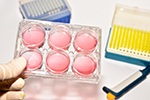
Over the holiday, my son and I decided to build a computer!
It's amazingly simple these days - a trip to the store for the components, a few hours to put it all together, and we had a working computer. It's so easy now because all the parts have been standardized and are designed to work together.
But, just think, what if repairing and growing human organs were this simple?
One of the major challenges is the lack of standardization in the procedures that produce stem cells. This means each lab may end up with different results.
To solve that problem, the National Institutes of Health (NIH) is now providing standardized stem cells directly for academic or commercial research or production. Two different types of stem cells are available - clinical grade stem cells for clinical research in humans and laboratory grade stem cells for basic and translational research.
To produce these cells, stem cells were isolated from human umbilical cord blood cells obtained during a normal delivery of a healthy baby. These cells were then induced back to a more primitive state in the lab to yield pluripotent stem cells.
With the right stimulus these cells can become any cell in the body. These stem cells have great potential for cures in diabetes, Parkinson's disease, Alzheimer's, muscular dystrophy, and spinal cord injuries.
In mice, stem cells have created insulin producing cells that reversed diabetes, and even restored limb function in animals with spinal cord injury.
Consider the implications if we can produce these results to help sick or injured people. That would be amazing - and it's starting to be within reach!
More Information
Stem Cell Basics
This primer on stem cells is intended for anyone who wishes to learn more about the biological properties of stem cells, the important questions about stem cells that are the focus of scientific research, and the potential use of stem cells in research and in treating disease...
Pluripotent Stem Cells 101
Pluripotent stem cells are master cells. They're able to make cells from all three basic body layers, so they can potentially produce any cell or tissue the body needs to repair itself. This 'master' property is called pluripotency...
NIH Regenerative Medicine Program (RMP)
The goal of the Regenerative Medicine Program (RMP) is to serve as a national resource for stem cell science to accelerate the development of new medical applications and cell-based therapies.